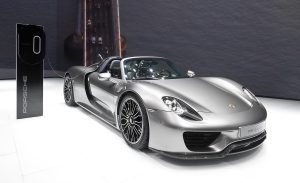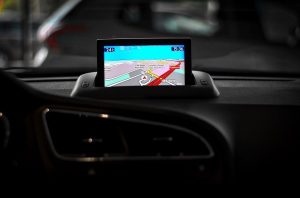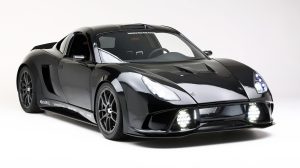Earlier this month, the US Air Force literally dropped a giant curtain to reveal its latest fighter jet: the F-15EX Eagle II. The ceremony at Eglin Air Force Base in Florida marked the official debut of the twin-engine aircraft, complete with puffs of fog to set the scene.
Despite some complaints about the jet’s uncreative new name, the Boeing-made fighter deserves a close look. Brand-new aircraft models don’t often enter service, and when they do, they fly for decades.
This model F-15 is the latest in a long line of aircraft with similar names dating back to the 1970s, so it can be hard to know precisely what is new about this grey winged machine. Here’s everything you might want to know about the F-15EX Eagle II and its metal ancestors—plus what one pilot says is the craft’s key weakness in 21st-century battles.

The history of the F-15 Eagle
If you close your eyes and picture a generic fighter jet—the kind you might see in a movie—you’re probably imaging something like an F-15 or F-16. (Although if you’re thinking about Top Gun, those were F-14 Tomcats.) All those letters and numbers can get confusing, so here’s what to know about the essence of the F-15 Eagle.
The Eagle is a child of the 1960s and 1970s, and it had a straightforward purpose: to excel at air-to-air fighting. “It comes from this unique historical moment,” says Michael Hankins, a curator with the National Air and Space Museum who is writing a book on both the F-15 and F-16. He pegs its genesis in 1964. “There’s a faction of folks, within the Air Force anyway, that have this idea that the traditional fighter mission, focusing on air-to-air combat, has not been adequately paid attention to.”
[Related: I flew in an F-16 with the Air Force and oh boy did it go poorly]
The Eagle grew out of that single-purpose mission. “The catchphrase became ‘not a pound for air-to-ground,” Hankins says, meaning the plane wouldn’t be equipped for dropping bombs. “It was all about air-to-air fighting.”
It’s a simple idea: create a flying hammer, not an airborne Swiss Army Knife.
The plane flew for the first time in the early 1970s, and Hankins says that in the decades since it has executed its mission superbly. “It’s got an incredible reputation,” he notes. “You can’t deny that the F-15 is one of the best air-to-air fighters in history, and I think it’s one of the most iconic.”
The F-15: An eye like a pizza pie
To be able to see distant adversaries, the jet needed a robust radar.
“They designed the aircraft based on the radar dish,” says Brian Kamp, who flew the F-15 for three decades and goes by the callsign Spiderman, or just Spidey. (You can listen to him talk about the Eagle on the Fighter Pilot Podcast.) He notes that the radar dish, which is located in the plane’s nose, in front of the cockpit, measures around 3 feet wide. “That’s a pretty big pizza,” he says.
That dish allows the aircraft to detect enemies from far away, so pilots could theoretically shoot them before they could even visually see them. But the reality of combat, and the “fog of war,” Kamp says, made the task more complex. “You don’t know if you can shoot this enemy plane, because you don’t know if it’s an enemy,” he notes. “There’s friendlies all around, there’s confusion, so you have to sometimes get into a visual arena, and get into a dogfight.”
But despite the complexity of air-to-air fighting, the results from the Eagle, whose job was to “win the skies,” were stellar. The F-15C model, he notes, “has the best record in history of aerial combat.” Its performance: “104 victories, zero losses, air-to-air.”
It’s also a very physically large aircraft. At about 64 feet long and 43 feet wide, it’s shorter than a tennis court but significantly wider. From the ground, the tops of its two tails rise nearly 19 feet high. Two engines power it, giving it a level or redundancy that a single-motor F-16 lacks.

Many aircraft have nicknames—the F-16 is known as the viper—and different versions of the F-15 are sometimes referred to by their paint color. The F-15C or D is a “light grey,” and the F-15E Strike Eagle (which, counterintuitively, has an air-to-ground mission) is a “dark grey.” It’s also sometimes called a “mud hen.”
It asks a lot of its pilots. Kamp notes that between just the stick and throttle controls in the cockpit, there are 16 switches. A single switch on the stick, he says, has “over 34 functions—one switch!”
[Related: A pilot passed out while flying an F-15 over Oregon. Here’s what happened next.]
Plus, there is little automation. Old-school planes like the F-15C model had mechanical linkages—elements like cables and pulleys—between the controls a pilot uses and the surfaces on the aircraft that move. “The Eagle has always been a manual aircraft,” Kamp says. He notes that the extent of its automation was literally just a single switch, which was for “altitude hold.” It did just that: told the plane to maintain a specific altitude. The F-15C and D aircraft do have a computer augmentation system for the flight controls, however, and the Strike Eagle has a more robust, digital version of the same.
Combine operating such a complex machine with the physical effects of the g-forces, and possibly the presence of an adversary, and you get an idea of what it’s like. “It’s the craziest, most bizarre, most complicated, most difficult sport that exists,” he says. “And it’s life or death.”

The F-15EX: The newest Eagle
The latest version of the Eagle—officially called the Eagle II—is what will carry aviators into that life-or-death contest. The C and D model F-15s are getting old, so this is what will replace them.
Pilots will now have a high-definition color touchscreen that measures 19 by 10 inches. A secondary screen is in the backseat for use if the rear spot is occupied (Netflix anyone?), although the plane will probably be occupied by just a single person most of the time.
The Eagle II is now completely fly-by-wire, too. Instead of those previous-gen pulleys and cables, the plane now digitally interprets how the pilot moves the controls, and then electronic signals talk to the rest of the aircraft. Pilots sometimes say that with this kind of aircraft, human aviators are just voting—they vote by moving the stick to tell the plane what they’d like it to do, while the flight control computer figures the rest out.
The plane also has what’s known as an “open mission system backbone,” says Maj. Aaron Eshkenazi, a pilot with the Air Force who has been flying the F-15EX. That makes the aircraft more modular. Engineers can plug software code into it for a new sensor or weapon, for example, and that system is “isolated from our safety of flight.”
Finally, the Eagle II is similar to what Boeing has already been making for foreign customers: the F-15SA for Saudi Arabia, and the QA for Qatar. The Air Force says it may purchase as many as 144 of them.
There’s one big thing the F-15 Eagle II can’t do
On the outside, the aircraft has a decades-old design, and that means there’s one thing it’s not: stealthy. Fifth-generation fighter jets, like the F-35, are designed to evade enemy radar. The F-15EX, or any other Eagle, is as loud and obvious as a football player. And for that reason, Heather Penney, who flew vipers for a decade (call sign: Lucky), is critical of the purchase.
“Stealth is the cost of entry to any modern battlespace,” Penney, now a senior resident fellow at the Mitchell Institute for Aerospace Studies, says. “And it does not matter how amazing the internal sensors, and avionics, and electronic warfare [capabilities] is.” The aircraft’s radar signature, she says, is “noisy.”
[Related: Watch a computer clobber a human pilot in a simulated fighter jet duel]
The context behind the purchase, she says, has roots in two issues: one is that it’s expensive for the Air Force to continually maintain fleets of dated jets. “The average age of an Air Force fighter nowadays is about 30 years old,” she says. She notes that the F-16 she flew dates to 1985, and it’s still kicking around. The other concern is the Air Force’s desire to diversify its base away from just Lockheed-Martin-made jets like the F-35—the Eagle II is made by Boeing.
She argues that a modern fighter jet should have a triad of capabilities: stealth, information systems presented to the pilot in a manageable way, and the ability to conduct electronic warfare and jam an enemy. “You cannot put this aircraft in the battlespace, because it’s missing one of those legs,” Penney says.
“When we buy fighter jets, it’s not about the cool factor,” she adds. “What matters is how we will be able to utilize them in combat, and how effective they will be for their pilots and for our nation.” She gives the Air Force’s decision a “big thumbs down.”

Predictably, some F-15 pilots disagree with that assessment. Eshkenazi, who is flying the F-15EX now, notes that the platform can carry a larger weapons payload than the F-35. For example, it can hold a dozen AMRAAM missiles.
He also points out that the Eagle makes a good distraction when paired with a stealth fighter, the same way a magician might pull your eyes towards something shiny to keep you from noticing a sneaky move. The Eagle could fly with an F-22 or F-35, for example, and the adversary’s eyes would be on the Eagle. “It allows my fifth-gen, and sixth-gen partners, to go in undetected,” Eshkenazi notes.
Kamp, the former Eagle pilot, agrees. Simply being seen can be a deterrence. “Our task is to clear the skies,” he says. “We don’t have to shoot one missile—we have to put fear in the enemy’s eyes, and have them turn away and go home.”






